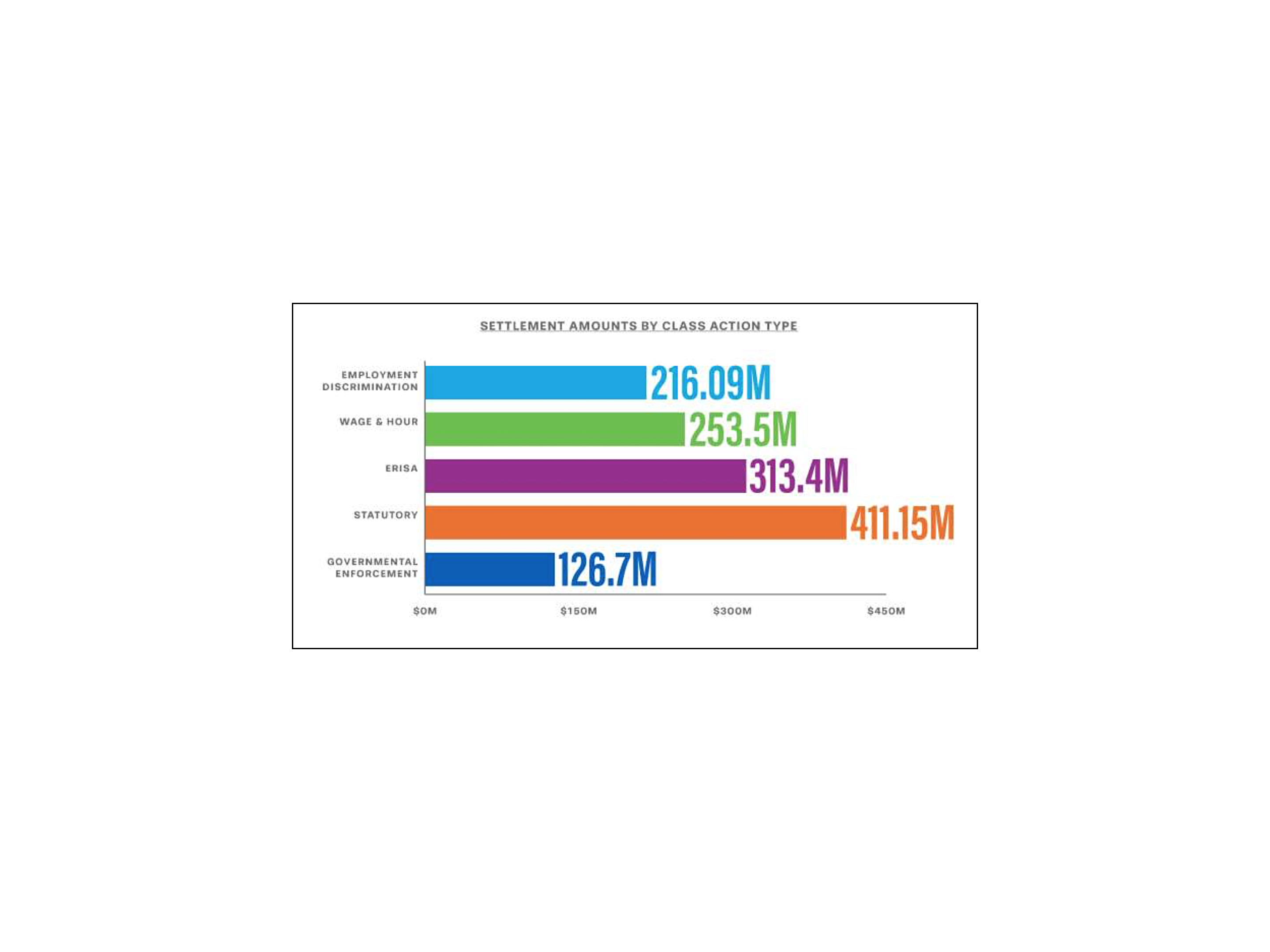Good and Bad News for Employers in Seyfarth Shaw 2019 Class Action Litigation Report
Seyfarth Shaw said its 2019 Workplace Class Action Litigation Report is its largest edition ever, with attorneys analyzing a record 1,453 class action rulings in state and federal courts.
January 09, 2019 at 05:18 PM
4 minute read

Employers and their general counsel saw good news and bad in workplace class action legal trends in 2018, according to a new report from Seyfarth Shaw. The good news: After reaching an all-time high of $2.7 billion in 2017, the value of top workplace class action settlements decreased by more than 50 percent in 2018, sinking to a five-year low of $1.3 billion.
The bad news for employers is for the first time in the report's 15-year history, plaintiffs posted a record-high certification success rate in 2018 of 79 percent in wage-and-hour litigation, which is the largest category of workplace lawsuits.
The law firm said its 2019 Workplace Class Action Litigation Report is its largest edition ever, with attorneys analyzing a record 1,453 class action rulings in state and federal courts.
Seyfarth partner Gerald Maatman said the most significant event last year was the U.S. Supreme Court's decision in a case involving software giant Epic Systems Corp. The court ruled that corporations can enforce employee arbitration agreements, thereby prohibiting employees from bringing class action suits in disputes over pay and workplace conditions.
Maatman said the ruling “will be with us for years to come, and will change the dynamics of class litigation. It is already having an impact, with plaintiffs' lawyers sending demand letters trying to negotiate settlements on behalf of people [employees] who are susceptible to a motion for arbitration.”
Plaintiffs lawyers typically start with one or two complaining clients, he explained, and then file a motion for class certification and a class list to enlarge the group. But if those clients have signed arbitration agreements, “then they [plaintiffs lawyers] can't get a big enough group to pursue a claim,” Maatman said.
He added, “It's going to be interesting in 2019 to see the impact on the number of class action cases filed, the number certified, and their level of value. The Epic ruling should cut down on the number of lawsuits and certifications, and make the cases worth less money.”
But Maatman suggested companies might see a stronger pro-worker push in Congress in the next two years, as well as in the next presidential election, in an effort to overturn the Epic decision.
“The #MeToo movement has placed the arbitration issue in the spotlight,” the attorney added. It was reported that many women involved in high-profile sexual harassment cases at corporations had signed agreements that kept details of their situations confidential and often prohibited class actions.
“Is it good policy or bad policy for a company to use these agreements?” Maatman asked. “It is not a one-size-fits-all decision. Each company must weigh the factors.”
Earlier this week the law firm issued a report that noted the significant impact of the #MeToo movement on litigation in 2018.
In the more recent class action report, the law firm noted a surprisingly sharp drop in settlement values this year. Maatman said several factors contributed to the dip, including the impact of the Epic case, and employers doing a more thorough job of following workplace laws.
“We are on the downside of a bell jar curve on settlement value,” he explained. “I think in 2019 we'll see lower values again. I don't know for how long the values will keep dropping. That could depend on whether there is a legislative response to the Epic Systems ruling.”
In other findings, the report said:
• Despite the transition to a more business-friendly Trump administration, government enforcement litigation rose again to a new three-year high in 2018. The Equal Employment Opportunity Commission filed 199 lawsuits last year, up from 184 in 2017.
• The value of the top government settlements also plunged, dropping from $485 million in 2017 to $126.7 million in 2018.
• The success of employer efforts to decertify class action cases dropped by 11 percentage points, as employers won only 52 percent, down from a 63 percent success rate in 2017.
This content has been archived. It is available through our partners, LexisNexis® and Bloomberg Law.
To view this content, please continue to their sites.
Not a Lexis Subscriber?
Subscribe Now
Not a Bloomberg Law Subscriber?
Subscribe Now
NOT FOR REPRINT
© 2025 ALM Global, LLC, All Rights Reserved. Request academic re-use from www.copyright.com. All other uses, submit a request to [email protected]. For more information visit Asset & Logo Licensing.
You Might Like
View All

Apple Disputes 'Efforts to Manufacture' Imaging Sensor Claims Against iPhone 15 Technology

Class Certification, Cash-Sweep Cases Among Securities Litigation Trends to Watch in 2025
6 minute read
'Serious Disruptions'?: Federal Courts Brace for Government Shutdown Threat
3 minute readTrending Stories
- 1Connecticut Movers: New Laterals, Expanding Teams
- 2Eliminating Judicial Exceptions: The Promise of the Patent Eligibility Restoration Act
- 3AI in Legal: Disruptive Potential and Practical Realities
- 4One Court’s Opinion on Successfully Bankruptcy Proofing a Borrower
- 5Making the Case for Workflow Automation
Who Got The Work
J. Brugh Lower of Gibbons has entered an appearance for industrial equipment supplier Devco Corporation in a pending trademark infringement lawsuit. The suit, accusing the defendant of selling knock-off Graco products, was filed Dec. 18 in New Jersey District Court by Rivkin Radler on behalf of Graco Inc. and Graco Minnesota. The case, assigned to U.S. District Judge Zahid N. Quraishi, is 3:24-cv-11294, Graco Inc. et al v. Devco Corporation.
Who Got The Work
Rebecca Maller-Stein and Kent A. Yalowitz of Arnold & Porter Kaye Scholer have entered their appearances for Hanaco Venture Capital and its executives, Lior Prosor and David Frankel, in a pending securities lawsuit. The action, filed on Dec. 24 in New York Southern District Court by Zell, Aron & Co. on behalf of Goldeneye Advisors, accuses the defendants of negligently and fraudulently managing the plaintiff's $1 million investment. The case, assigned to U.S. District Judge Vernon S. Broderick, is 1:24-cv-09918, Goldeneye Advisors, LLC v. Hanaco Venture Capital, Ltd. et al.
Who Got The Work
Attorneys from A&O Shearman has stepped in as defense counsel for Toronto-Dominion Bank and other defendants in a pending securities class action. The suit, filed Dec. 11 in New York Southern District Court by Bleichmar Fonti & Auld, accuses the defendants of concealing the bank's 'pervasive' deficiencies in regards to its compliance with the Bank Secrecy Act and the quality of its anti-money laundering controls. The case, assigned to U.S. District Judge Arun Subramanian, is 1:24-cv-09445, Gonzalez v. The Toronto-Dominion Bank et al.
Who Got The Work
Crown Castle International, a Pennsylvania company providing shared communications infrastructure, has turned to Luke D. Wolf of Gordon Rees Scully Mansukhani to fend off a pending breach-of-contract lawsuit. The court action, filed Nov. 25 in Michigan Eastern District Court by Hooper Hathaway PC on behalf of The Town Residences LLC, accuses Crown Castle of failing to transfer approximately $30,000 in utility payments from T-Mobile in breach of a roof-top lease and assignment agreement. The case, assigned to U.S. District Judge Susan K. Declercq, is 2:24-cv-13131, The Town Residences LLC v. T-Mobile US, Inc. et al.
Who Got The Work
Wilfred P. Coronato and Daniel M. Schwartz of McCarter & English have stepped in as defense counsel to Electrolux Home Products Inc. in a pending product liability lawsuit. The court action, filed Nov. 26 in New York Eastern District Court by Poulos Lopiccolo PC and Nagel Rice LLP on behalf of David Stern, alleges that the defendant's refrigerators’ drawers and shelving repeatedly break and fall apart within months after purchase. The case, assigned to U.S. District Judge Joan M. Azrack, is 2:24-cv-08204, Stern v. Electrolux Home Products, Inc.
Featured Firms
Law Offices of Gary Martin Hays & Associates, P.C.
(470) 294-1674
Law Offices of Mark E. Salomone
(857) 444-6468
Smith & Hassler
(713) 739-1250






